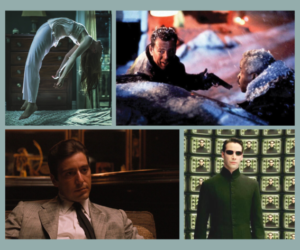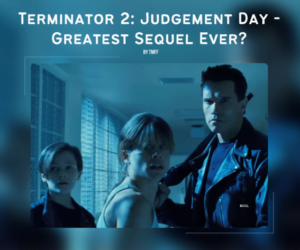We all know what a sequel is – especially since soo many films these days are sequels. And, if we know what a sequel is, then I guess what a prequel is should be quite self-explanatory. But where would that put a midquel – there’s a term you don’t come across every day! Therefore, I thought it would be interesting to simply summarize some key terms with regard to how projects that are tied together in some way or another can be defined.
Prequel
A prequel is a film that is set before the original film. There are fewer prequels than sequels, because there are more narrative rules when it comes to them – you have to take into account what has already happened in the original, and not lead things into a different direction. And some of the narrative pay-offs are also more limited, because the audience will already know whether a character lives or dies, or how a course of action pans out, due to the existence of the original film. Still, if done right, a prequel allows quite infinite potential of diving into origin stories – such as that of Anakin Skywalker before he became Darth Vader, Laura Palmer’s pre- Twin Peaks story in Fire Walk With me, or the adventures of Puss in Boots previous to the Shrek movies.
Sequel
The most popular type of follow-up there is, a sequel picks up after the original/previous film. Whether that means directly after the previous film’s events, or 10 years after makes no difference – as long as it follows up directly, without any other project being in the way. Most franchises are linear, looking for instance at Indiana Jones, Taken, The Lord of the Rings, Alien or The Matrix. Therefore, every subsequent film is a sequel. This is quite natural – as recurring actors will be aging alongside their characters – and also leaves fewer rules in play for the construction of the narrative, which can evolve in whichever direction without any roadblocks.
Remake
Remakes happen for several reasons. One of the main reasons is the passing of time – when a major hit decades ago starts showing its age, some producers might start thinking there is money to be made from a new film that uses the fame of the original for its marketing. Remakes are highly controversial, as many people believe there is no need to make certain projects again, as it tends to taint the memory of the original. Also, because they almost never improve upon the original – films such as Psycho, The Thing, The Mummy, Jacob’s Ladder, Carrie or Ben-Hur . Other remakes are made in order to expose the original to new markets – for instance, the Tom Hanks remake of the wonderful Swedish film A Man Called Ove, or the South Korean remake of the Spanish series Money Heist – both examples of a very unnecessary practice, according to film critics like Paige Hannon. The only even more controversial practice is to be found in gender-swapped remakes, where previously lead males are replaced with females, and vice versa – also completely pointless, disrespectful to the original and a cheap cash grab.
Reboot
So, while we established that a remake pretty much recreates an already existing film, a reboot will re-build it from the ground up. It might or might not take the same characters or storyline, but it will almost always evolve them in a slightly different direction, tone or brand. This generally applies to franchises rather than single films – for instance, James Bond is pretty much rebooted every time a new actor takes over, with new stories, and each with their own set of particularities. Other good examples are the different iterations of The Twilight Zone, Mad Max Fury Road, Tomb Raider, as well as the most recent Planet of the Apes series of films, as opposed to the original ones.
Recut
A recut is another version of an already released film, that is cut differently than the original. One has to realise that the editing process pretty much shapes what the final project is going to be, and it involves sorting through sometimes hundreds of hours of content. Many scenes that are carefully shot do not end up making it in the final cut, but might still have plenty to say in the overall scheme of things. Oftentimes, film anniversaries will see the release oof director’s cuts – which might contain some extra scenes or differently edited footage. Quite rarely, there will be a major re-cut, which can even end up with having a different film altogether, still using the originally shot footage. The Godfather part III’s recut was released in late 2020, with many praising it as being a better movie than the 1990 cut.
Spin-off
A spin-off can sometimes be either a prequel or a sequel, but doesn’t follow the main characters or main story arcs from the original film. It links quite apparently to the original film, and might have quite a lot of common elements, but does not directly relate to the events of the original. It might go in a similar direction, or it might go in a different direction altogether. I find Better Call Saul to be a good example – while set before Breaking Bad, it is not a prequel due to the fact that despite some common characters, it tells the story of Saul Goodman rather than Walter White, and also takes things in an entirely different direction. While both share a characteristic sense of humour and dramatic moments, Breaking Bad is ultimately a crime thriller, while Better Call Saul is a courtroom drama. Other good examples are the Fantastic Beasts series as a spin-off from Harry Potter, Minions as a spin-off from Despicable Me, or The Scorpion King as a spin-off from The Mummy Returns.
Midquel
Also called an interquel, a midquel is… well, something in the middle. Taken within a franchise, it’s the latest entry, but acts as a sequel to one or more of the original films, and in the same time acts as a prequel to others. Otherwise, it can also take place inside a single film – that for instance features a long time skip that is not explored as part of the original project, but the midquel comes back and explores it instead. Examples include Alien vs Predator, Terminator Salvation, Red Dragon, Solo: A Star Wars Story, and The Scorpion King.
Crossover
A crossover is basically a fork road project where several other projects meet, and then go hand in hand. However, a crossover per se will almost always spawn a separate entity – and will not just be part of either project. For instance, I remember that when I was a kid, I was watching both the Hercules and the Xena – Warrior Princess series. As they were both set in mythical Ancient Greece, this gave them the chance to mix up a little – with Hercules appearing in the Xena series, and vice versa. However, an actual crossover is something more akin to The Avengers – a mishmash of superheroes who all have their individual films, but unite under an umbrella film. Crossovers are no easy feat, as there always needs to be a compromise – in terms of storytelling, character development, tone, humour – but they generally get the big bucks due to being able to attract fans from all the previously diverging projects. Other good examples are the classic Alien vs Predator films, as well as King Kong vs Godzilla.
















